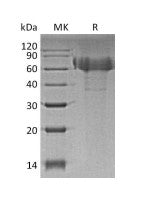1
/
of
2
Recombinant Human TIM-4 (C-6His)
Recombinant Human TIM-4 (C-6His)
Recombinant Human T-cell Immunoglobulin And Mucin Domain-containing Protein 4 is produced by our Mammalian expression system and the target gene encoding Glu25-Leu315 is expressed with a 6His tag at the C-terminus.
Catalog No:
EPT185
Regular price
$610.00 USD
Regular price
$469.00 USD
Sale price
$610.00 USD
Unit price
/
per
Couldn't load pickup availability
Product Details
Accession
AAH08988.1
Molecular Weight
32.3 KDa
Apparent Molecular Weight
60-90 KDa, reducing conditions
Purity
Greater than 95% as determined by reducing SDS-PAGE.
Endotoxin
Less than 0.1 ng/µg (1 EU/µg) as determined by LAL test.
Expression Host
Mammalian
Reconstitution
Always centrifuge tubes before opening.Do not mix by vortex or pipetting.
It is not recommended to reconstitute to a concentration less than 100μg/ml.
Dissolve the lyophilized protein in distilled water.
Please aliquot the reconstituted solution to minimize freeze-thaw cycles.
Shipping Condition
The product is shipped at ambient temperature. Upon receipt, store it immediately at the temperature listed in the Storage field.
Storage Condition and Shelf Life
Lyophilized protein should be stored at < -20C, though stable at room temperature for 3 weeks.
Reconstituted protein solution can be stored at 4-7°C for 2-7 days.
Aliquots of reconstituted samples are stable at < -20C for 3 months.
Background
T-cell Immunoglobulin and Mucin Domain-containing Protein 4(TIM-4) belongs to the immunoglobulin superfamily, is a member of the TIM family of immune regulating proteins. TIMs are type I transmembrane proteins with one Ig-like V domain and one Ser/Thr-rich mucin domain. Structurally, TIM-4 is distinguished from other TIMs by the presence of an RGD motif in its Ig domain and the lack of a site for tyrosine phosphorylation in its cytoplasmic tail. The mucin domain in TIM-4 is larger than in TIM-1 or TIM-3. TIM-4 is expressed by macrophages and mature dendritic cells but not by lymphocytes. it is Involved in regulating T-cell proliferation and lymphotoxin signaling.The interaction of TIM-4 with TIM-1 induces costimulatory and hyperproliferative signals in T cells. TIM-4 binds specifically to TIM-1 which is also the cellular receptor for the hepatitis A virus, and has been implicated in the development of asthma.
Analyte
TIM-4
Regulatory Status
For Research Use Only



